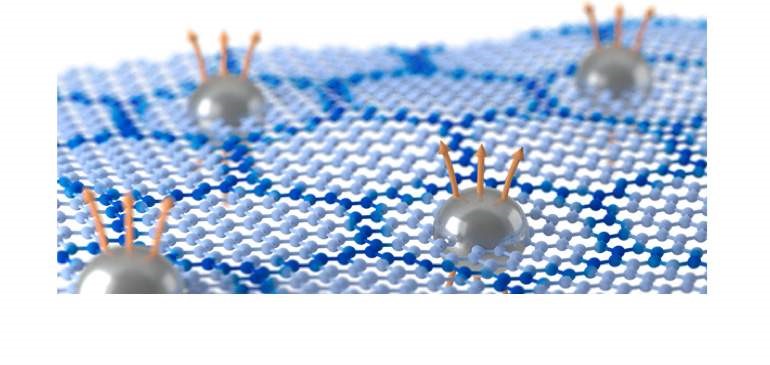Discovering previously unobserved quantum states nested inside the quantum Hall effect in a single-layer form of carbon known as graphene, researchers have found evidence of a new state of matter that challenges scientists' understanding of collective electron behavior.
 |
|
Artist depiction of the fractional quantum Hall effect in moiré patterned graphene.(Photo courtesy of National High Magnetic Field Laboratory) |
First, some background
Graphene is an exciting, Nobel-Prize-winning material that researchers believe may have applications in computers, batteries, cell phones, televisions and even airplanes. A one-atom thick, honeycomb array of carbon atoms, graphene is virtually see-through, yet 300 times stronger than steel and 1,000 times more conducting than silicon.
When a magnetic field is applied perpendicular to the flow of electric current, a transverse voltage develops across the material. Initially discovered in 1879, this is known as the Hall effect. Nearly a century later, researchers earned a Nobel Prize for the uncovering special resistance-free conducting states, quantum in origin, that occur when at very specific magnetic fields. Known as the quantum Hall effect, these states, observed in two-dimensional structures, corresponded to new states of matter.
What did scientists discover?
Working with a unique combination of graphene and boron nitride arranged like a sandwich, scientists at the MagLab observed a new kind of quantum Hall state that does not fit into any existing classes of quantum Hall states. This new phase emerges when strongly interacting electrons move in a spatially periodic structure under the influence of a magnetic field.
Why is this important?
The fractional quantum Hall effect is at the heart of one of the outstanding problems in modern condensed matter physics — understanding how large collections of interacting quantum particles behave together in concert, giving rise to new characteristics that are not a feature of the individual parts. Some fractional quantum Hall states may one day be used as qubits (quantum bits) in future quantum computers or have other exciting applications that scientists can not yet predict.
Read more at MagLab users observe new type of fractional quantum Hall effect.
Who did the research?
L. Wang1,2, Y. Gao1, B. Wen3, Z. Han3, T. Taniguchi4, K. Watanabe4, M, Koshino5, J. Hone1, and C.R. Dean3
1Department of Mechanical Engineering, Columbia University; 2Department of Electrical Engineering, Columbia University;3Department of Physics, Columbia University; 4National Institute for Materials Science; 5Department of Physics, Tohoku University
Why did they need the MagLab?
THE TOOLS THEY USED
This research was conducted in the 31 T magnet (cell 9), and45 T magnet (cell 15) at the MagLab's DC Field Facility.
The high-field measurements were performed at the DC Field Facility in Tallahassee, Florida. The unique capability of the hybrid magnet at this facility, which is able to produce fields up to 45 tesla, while cooling the sample to millikelvin temperatures, was essential to this research. "The combination of large fields, where electron interactions become strong, and low temperature, where small energy gaps can be observed, was crucial," explains Columbia professor Cory Dean, a collaborator on this research. "Not to mention the truly remarkable technical support at the MagLab, which makes this kind of extreme measurement possible."
Details for scientists
Funding
This research was funded by the following grants: C.R.D. was supported by the US National Science Foundation under grant no. DMR-1463465 NSF DMR-0654118
For more information, contact Tim Murphy.
Details
Research Area:Graphene
Research Initiatives:Materials
Facility / Program:DC Field
Year:2016





 CN
TW
EN
CN
TW
EN






